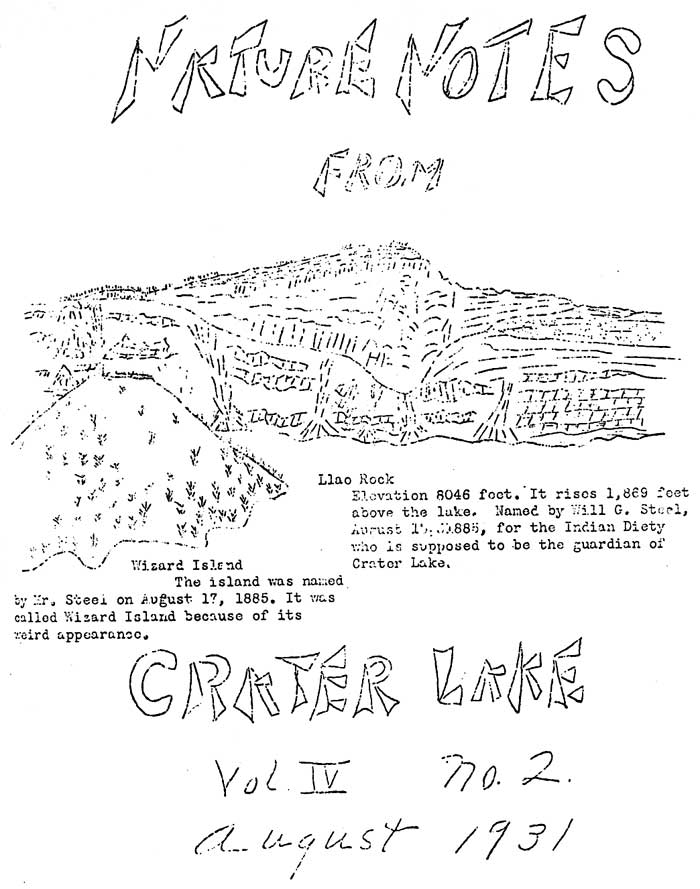Volume 4 No. 2 – August 1, 1931
All material courtesy of the National Park Service.These publications can also be found at http://npshistory.com/
Nature Notes is produced by the National Park Service. © 1931
Another Page from the Past Discovered
By D. S. Libbey
“Nature! We are surrounded and embraced by her; powerless to separate ourselves from her, powerless to penetrate beyond her.”
“She is ever shaping new forms, what is, has ever been; what has been, comes not again. Everything is new, and yet naught but the old.”
—– Goethe —–
In last month’s Nature Notes mention was made of the numerous discoveries of carbonized wood or natural charcoal which have been made in the vicinity of the Rogue River where the Diamond Lake Road leaves the main highway. The writer has been back to the place of the fossil finds several times in an effort to secure a complete cross-section and after many futile efforts finally succeeded in securing a cross-section 28 inches in diameter, on Thursday, July 23.
Mr. Harshbarger, of the Clarence Young Construction Company, which is doing the excavating through the volcanic tuff and pumice on the Diamond Lake Road, called us to come down the side of the mountain some twenty miles and investigate the nature of the huge carbonized log which was found approximately 1850 feet above the place where the new road joins the Medford Highway. The log was covered by 55 feet of volcanic ash and pumice which has become thoroughly consolidated and the specimen was in a prostate position but with several lateral branches attached. The under side of the log still carried the thick layers of bark resting against very fresh appearing volcanic ash of a light gray color. The portion of the bark which was on the under side was in a remarkable state of preservation, uncarbonized, and the bark marking were very evident. The bark shows the characteristics of the Sugar Pine bark (Pinus lambertiana, Dougl.) and the carbonized log has numerous portions showing the vesicular structure (bubbles and globules) caused by the baking of the pitch in the log. Apparently the log was one which had just fallen prior to its entombment and the fact that carbonized branches were discovered seems to substantiate this opinion.
This find, in-situ, is considered a great value and the cross-section has been placed in the Sinnott Memorial Building where it will finally be assigned a very conspicuous place. The fossil section is now held intact by a girdle of pine boards securely bound by wire so as to make a retaining support. Very probably the section will subsequently be either bound together by a series of brass straps or incased in a matrix of plaster of paris because the terrific heat to which the log was subjected caused rather large crevices to form and the entire mass is very friable. This index from the past has the honor of being the first display exhibit to be placed in the now Memorial Building which was just dedicated on Thursday, July 16.
A week previous we had the pleasure of discovering another fossil log approximately 8509 feet down from the Medford Highway junction on the same construction project. One end of the log had been turned to charcoal, the other being of uncarbonized wood. The end of the preserved wood was covered by small pumice gravels and ash fragments which apparently had tumbled down an ash and pumice slope and the very definite bedding showed that the gravels were resting at the definite angle of repose for such material and it is apparent that the covering ash and pumice for the uncarbonized had come to rest and had tumbled down the slope while cold. Also the log possessed no limbs and indicated that it had floated to its place and then been buried under the cold pyroclastic material. Very probably the entire log may have been covered and then subsequent stream erosion had uncovered the lower end of it, that is the end nearer to the present course of the Rogue. Very definite stream laid depositions of gravel and sand were discovered both above and below the site of the specimen. A part of the uncarbonized wood has been obtained and will be placed in the Sinnott Memorial building along with the large cross-section of the carbonized log. The sequence of events seems to be that after the work of water had sorted the pumice load, a huge deposit of volcanic ash and pumice was spread over the material while the volcanic ejecta was still hot and hence the carbonizing of the down stream, and, incidentally, the westerly end of the log. It is unfortunate that the steam shovel had destroyed all possibility of obtaining a cross-section of the log which would have shown the joining of the carbonized with the non-carbonized portion of the log. The overburden was about thirty feet thick.
It is apparent that the vast volcanic explosion which hurled the nearly incalculable mass of ash and pumice occurred recently, that is speaking in terms of geological time. The nearest orifice from which such explosive material might have come appears to be the caldera of old Mount Mazama.



